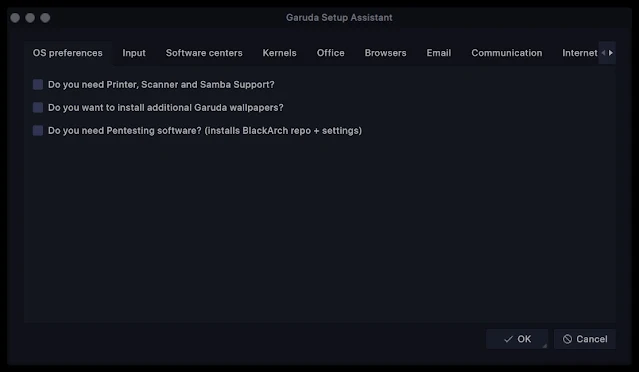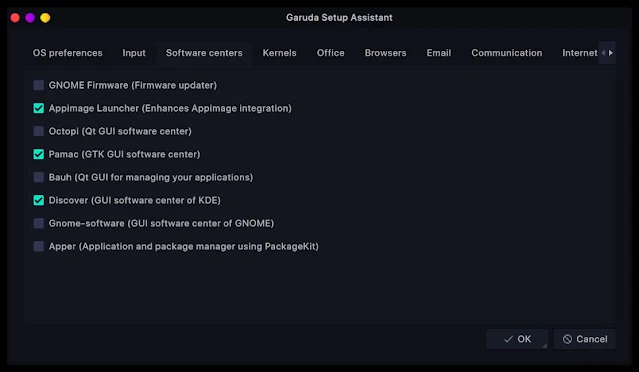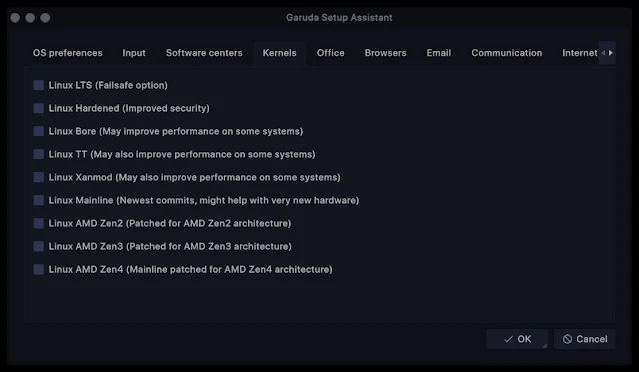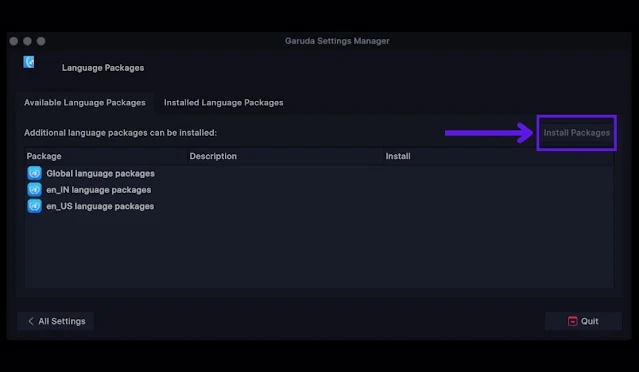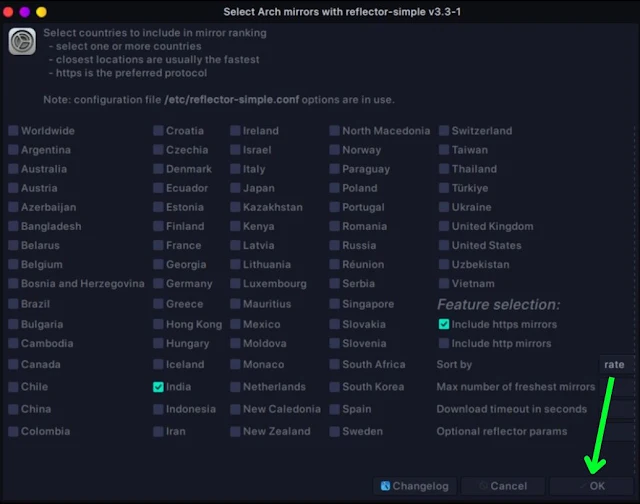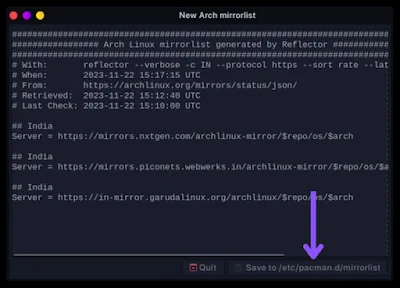So you installed Garuda Linux, Congrats. Now you thinking about what I do next so today I will tell you what to do after completing the Garuda installation. These steps can help you to speed up your system and diagnose some issues.
Garuda Welcome application
When you boot in the first time after installing Garuda an application called “Garuda Welcome” will auto-start so let's do things within the application.
Using this application we can perform many tasks like installing gaming components, packages, kernel language etc. Overall this application gives you a short way to make your Garuda Linux as you like.
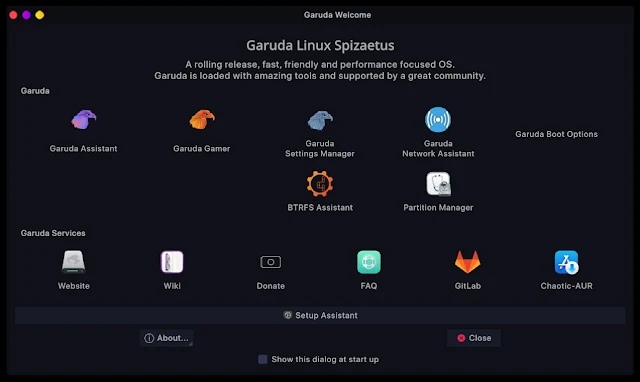 |
| You can find "Setup Assistant" at the bottom |
In the Garuda welcome application screen click on “Setup Assistant”. Now a new window appears welcoming you in Garuda Linux click on OK.
Next Garuda opens a new window and here enter your password to update the system.
Now Garuda SetupAssistant asks you to install drivers, Repositories and software for printers, scanners etc. Click on the option you want to install for example I want to install additional wallpaper and pen testing software so I selected both options.
Now go to the next tab within Garuda Setup Assistant called "Input" Here you can select packages and settings related to the keyboard you can add fonts using this tab select the option you want to add or move on next tab.
Now we are in the "Software Centre" tab in this you can install the GUI software installer and application related to managing software.
After selecting the option move to the next tab called "Kernels" Here you can install available kernels as you need.
The next tab is the "Office" tab here you can install WPS, Libre Office and other software related to office work. The next tab is "Browers" As the name suggests it is related to browsers here you can install the browser you need. Like Firefox, Tor, Opera etc.
Our next tab is for email and here you can install email clients like Thunderbird, Kmail etc. After this, the tab is related to communication and you can install telegram, discord, zoon etc software.
In the "Internet" tab, you can install download managers, FTP clients, torrent clients etc. After this two tabs are "Audio" and "Video" and here you can select and install software related to audio and video and our favourite VLC media player is available. And another tab called "Multimedia" is also related to this.
Now “Graphics”. If you are going to use Gardau for graphics-related work you can install software for this. After this the tab "Development" is for coding related here you can install IDE and compilers. Next is the "Virtualization" tab here you can install software like Virtual Box if you want to use another OS.
After selecting all the software you want to install click on “OK”. and let Garuda install all the applications.
Install drivers in Garuda Linux
The next thing you should do is install drivers for hardware so that you can take the best of hardware. To installll drivers open the Garuda welcome application and go to Garuda setting manager> hardware configuration.
In the hardware configuration, you will see some drivers check the box to select and click on “Auto Install Open-Source driver” to install the driver in your Garuda. After completing you should use drivers, if not reboot your system.
Install language packages in Garud Linux
The next thing you need to do after installing Garuda is to install language packages because Some applications distribute their language packs as separate packages, requiring an additional installation step after the initial setup. So to install language packages again go to Garuda Welcome > Garuda Settings Manager.
Here select Language Packages and in a new window click on “Install Packages” This will install some language packages that are needed by some applications.
You can see installed languages in the “Installed languages Packages” tab.
Increase internet speed in Konsole/Terminal
You installed Linux so definitely you are going to use a terminal and by default, the speed of the internet in the terminal is slow to increase this we can set the server to our nearby server CDN. but I'm not going to use the GUI method as some of the users are beginners to Linux so I am going to use the GUI method with the Reflector tool.
For this process go to “Garuda Welcome > Garuda Assitant” and open “Refresh Mirror-List”. Now a new window appears here check the box next to your nearest countries and click on OK.
Now Gardua compares the selected countries and then automatically selects the fastest server and now a new Window appears (etc/pacman.d/mirrorlist) with the new updated server click on “Save to etc/pacman.d/mirrorlist” to save the configuration.
Optimize File System for Speed in Garuda Linux
fstrim.timer is a system service on Linux that manages the execution of another service, fstrim.service. You can maximize your disk's performance by activating the fstrim.timer service. To do this open the terminal and run the following command:
sudo systemctl enable fstrim.timer
This scheduled service trims unused blocks, preventing performance degradation over time.
Strengthen the security of your system
Firejail is a security tool for Linux that helps isolate applications by restricting their access to the system. It acts like a sandbox, creating a controlled environment for programs to run in.
We can Strengthen system security by sandboxing applications using Firejail:
sudo pacman -S firejail
For example, run Firefox within a secure sandbox:
firejail firefox
This precautionary measure reduces potential security risks associated with Internet browsing.
Implement UFW for Firewall Protection
An uncomplicated Firewall, or UFW, is a firewall management tool designed for ease of use on Linux systems. It acts as a user-friendly interface for the powerful but complex iptables firewall, which is built into the Linux kernel. It will Enhance your system's firewall capabilities. To implement this run:
sudo pacman -S ufw
sudo ufw enable
Configure UFW to allow only necessary incoming and outgoing traffic, adding an extra layer of security to your Garuda Linux system.
Gesture Support for Touchpad
For users with touchpad support, enable gestures for an enhanced navigation experience. Now how we can do it, is using libinput-gestures, this is a program for Linux that allows you to customize touchpad gestures on your system.
sudo pacman -S libinput-gestures
Configure gestures to streamline your interaction with the touchpad.
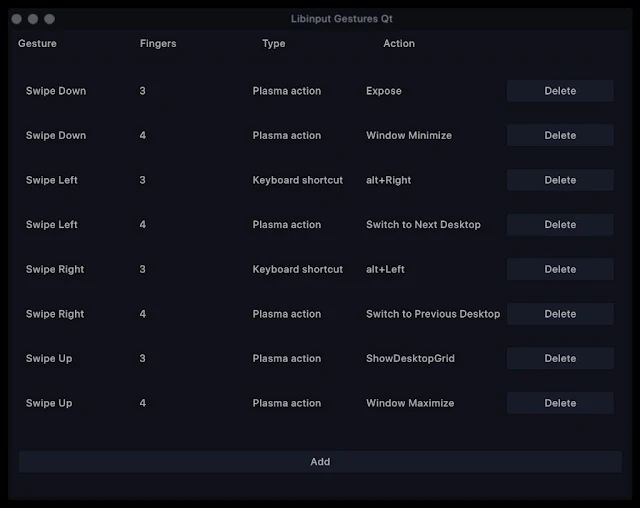 |
| You can add a new gesture here. |
CPU Governor Optimization
Enhance your system's responsiveness by adjusting the CPU governor. Install cpupower and set it to 'performance' mode:
sudo pacman -S cpupower
sudo cpupower frequency-set -g performance
This ensures that your CPU operates at maximum performance, ideal for resource-intensive tasks.
Now in the last Reboot, the system applies some changes by running the command:
sudo reboot
Final Thoughts
Garuda is a powerful Linux distro with beauty and personally, I like Garuda. If you install Gardau first time you may face some issues you can find solutions on Garuda’s forum. These steps I mentioned in this blog will help you to make Garuda faster and solve many issues.
If you like this article share it with your Garuda Linux user friends, follow us on our social handle and subscribe to our newsletter to never miss an important update.


